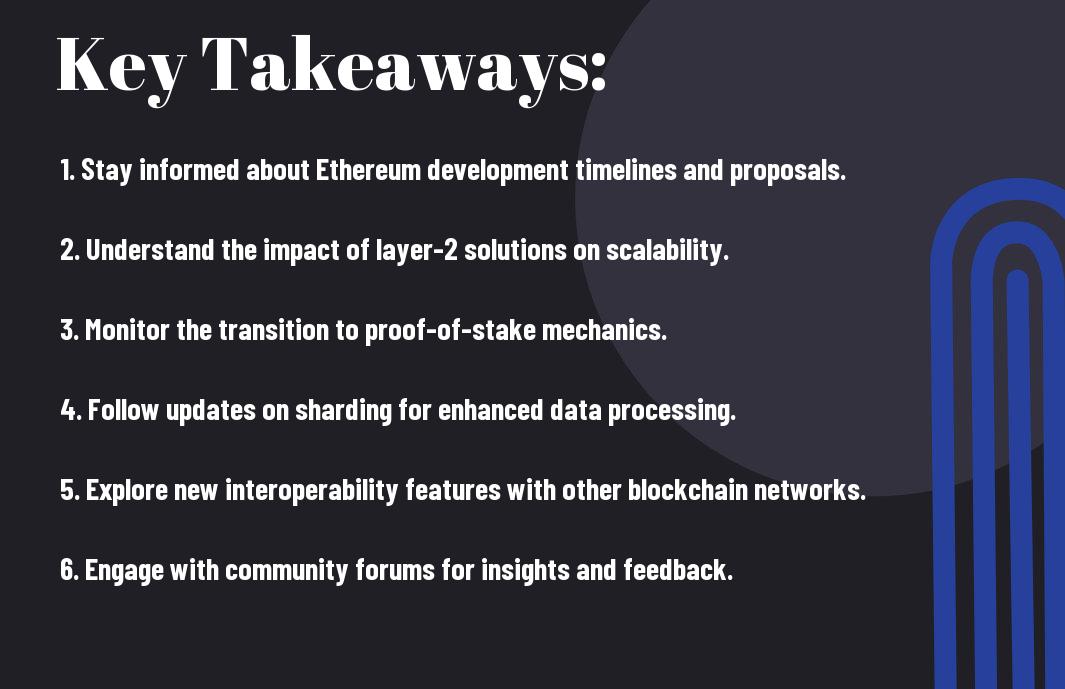Now Reading: Ethereum Upgrades – 8 Critical Steps For Navigating Future Developments
-
01
Ethereum Upgrades – 8 Critical Steps For Navigating Future Developments
Ethereum Upgrades – 8 Critical Steps For Navigating Future Developments

You need to stay informed about the evolving landscape of Ethereum upgrades to maximize your investments and ensure your projects remain relevant. As the network transitions toward Ethereum 2.0 and embraces significant changes, understanding these 8 pivotal steps will equip you to effectively navigate future developments. Emphasizing scalability, security, and sustainability, these upgrades will impact your experience within the ecosystem. This post will provide you with the vital insights required to thrive in a rapidly changing blockchain environment.
Key Takeaways:
- Understanding Upgrade Phases: Familiarize yourself with the distinct phases of Ethereum upgrades to better anticipate changes and enhancements.
- Community Engagement: Engage with the Ethereum community to stay updated on proposals, discussions, and feedback influencing future developments.
- Scalability Solutions: Pay attention to scalability solutions, as they are key to Ethereum’s ability to support a growing user base and applications.
- Security Practices: Adapt to evolving security practices to protect your assets and understand vulnerabilities that may arise during upgrades.
- Trend Analysis: Analyze trends in the blockchain space to position yourself strategically regarding investment and participation in Ethereum’s ecosystem.

Understanding Ethereum Upgrades
A comprehensive grasp of Ethereum upgrades is crucial for navigating the platform’s dynamic landscape. As Ethereum evolves, its upgrades bring significant improvements in performance, security, and scalability, directly impacting your experience as a user. Staying informed about these updates can help you make better decisions regarding your investments and participation in the network.
Historical Context of Ethereum Updates
By examining the historical timeline of Ethereum updates, you can better appreciate how the platform has evolved since its inception in 2015. Key updates like the DAO hard fork and Ethereum 2.0 lay the groundwork for future enhancements, while providing insights into how the community has reacted to challenges over the years.
Significance of Upgrades in Ecosystem
Behind every upgrade lies potential for improved functionality and user experience within the Ethereum ecosystem. These changes not only enhance security and scalability for developers but also provide a more robust platform for you as a user, positively impacting the overall health of the network.
Further exploring the significance of upgrades reveals their capacity to reshape the Ethereum ecosystem. Each update can lead to increased transaction speeds, reduced gas fees, and the introduction of new capabilities that can foster innovation. By embracing these enhancements, you’re positioning yourself for success amid the rapidly changing digital landscape. However, it’s also important to be aware of potential downsides, such as temporary disruptions during implementations. Understanding these aspects ensures you remain informed and equipped to navigate your Ethereum journey effectively.
Major Upcoming Upgrades
It is important to stay informed about the major upcoming upgrades in the Ethereum network as these developments can significantly enhance functionality and scalability. With upgrades like Ethereum 2.0 transitioning to a proof-of-stake consensus mechanism, you will witness improvements in transaction speeds and reduced energy consumption. Each upgrade aims to cater to the evolving needs of the ecosystem while addressing security and performance challenges.
Overview of Ethereum Improvement Proposals (EIPs)
After understanding the upgrade landscape, you need to examine the Ethereum Improvement Proposals (EIPs), which are vital for driving the network’s evolution. EIPs serve as a roadmap for developers and stakeholders, detailing proposed changes and enhancements. By keeping tabs on relevant EIPs, you ensure that you remain aligned with the community’s goals and can anticipate future advancements.
The Impact of Layer 2 Solutions
Impact is felt significantly in the Ethereum ecosystem with Layer 2 solutions like Optimistic Rollups and zk-Rollups, designed to bolster efficiency and reduce gas fees. These innovations can transform your user experience by enabling faster transactions and increased throughput on the network, addressing critical scalability concerns. As these solutions gain traction, you’ll be better positioned to leverage Ethereum for your decentralized applications and transactions.
Ethereum is actively evolving, and its Layer 2 solutions play a vital role in this journey. These solutions focus on moving the majority of transaction loads off the main blockchain, enhancing speed and reducing congestion. However, while they promise improved scalability, they also present complexity in terms of integration and potential security risks if not properly implemented. Understanding these dynamics will equip you to navigate the Ethereum ecosystem effectively, ensuring that you capitalize on benefits while being mindful of inherent challenges.
Transition to Proof of Stake
Keep an eye on the transition to Proof of Stake (PoS), which represents a significant shift in Ethereum’s consensus mechanism. This upgrade aims to enhance security, scalability, and sustainability, addressing critical concerns associated with the previous Proof of Work (PoW) model. As the landscape evolves, being informed about these changes will help you better navigate your investment decisions and participate in the Ethereum community.
Benefits of Proof of Stake
An exciting advantage of Proof of Stake is its energy efficiency. Unlike PoW, PoS does not require massive amounts of computational power, leading to a lower carbon footprint and reduced energy consumption. Additionally, PoS allows you to earn rewards by staking your Ether, creating a more accessible way to participate in network validation and governance.
Challenges and Considerations
After the shift to Proof of Stake, various challenges and considerations may arise. You should ponder potential security risks, centralization concerns, and the intricacies of staking rewards.
Consequently, it’s vital to evaluate the potential security risks that come with PoS, as the model changes how validators are chosen. Centralization might become a concern if a few entities control large amounts of staked Ether, which could undermine the network’s decentralization ethos. Moreover, the complexity of staking rewards might make it difficult for newcomers to understand how to maximize their earnings. By weighing these factors, you can make informed decisions regarding your involvement in Ethereum’s future.
Scalability Solutions
For anyone involved in Ethereum, scalability is imperative to ensure that the network can handle increased demand and usage. As Ethereum experiences growing popularity, solutions that enhance its ability to process transactions and execute smart contracts efficiently become increasingly important. Employing innovative strategies can significantly improve transaction speeds and lower costs, ultimately benefiting users like you.
Sharding Explained
Below, you will find that sharding is a method to improve Ethereum’s scalability by splitting the blockchain into smaller, manageable segments called “shards.” Each shard manages its own transactions and smart contracts, allowing for parallel processing. This means that the system can handle multiple transactions simultaneously, increasing overall efficiency and reducing congestion within the network.
Rollups and Their Role
The introduction of rollups brings a transformative approach to scaling Ethereum. These solutions aggregate and process multiple transactions off-chain while only submitting the final result back to the main Ethereum chain. This significantly reduces the load on the main network and improves transaction speeds, benefiting your experience as a user.
Also, rollups come in two primary forms: Optimistic Rollups and ZK-Rollups. Optimistic rollups assume transactions are valid by default and only challenge them if there’s a dispute, which makes them faster but potentially less secure. In contrast, ZK-rollups employ cryptographic proofs to validate transactions before they’re added to the blockchain, enhancing security and efficiency. Understanding these roles is imperative as they can lead to lower transaction fees and help the network scale, thus greatly enhancing your overall Ethereum experience.
Security Enhancements
Not only does Ethereum seek to improve scalability and efficiency, but it also places a strong emphasis on security enhancements. As the Ethereum network evolves, you must be aware of the various measures being implemented to strengthen the overall security framework, ensuring your assets and transactions remain protected against emerging threats.
Addressing Vulnerabilities
Before stepping into Ethereum’s future, it’s imperative to understand how vulnerabilities are identified and addressed. The Ethereum community actively conducts audits and peer reviews to uncover potential weaknesses. As you engage with the ecosystem, staying informed about these findings will help you make sound decisions and keep your investments safe.
Governance in the Upgraded Ethereum
Vulnerabilities in governance can significantly impact network decisions and stakeholder interests. The upgraded Ethereum will introduce enhanced governance mechanisms meant to offer greater transparency and inclusiveness. This means you will have a more pronounced role in discussions and decisions regarding protocol changes, ensuring your voice matters.
For instance, the introduction of on-chain governance mechanisms will allow you to participate in a more democratic decision-making process. This system aims to foster collaborative development while mitigating risks associated with arbitrary changes. As you engage with these governance models, you’ll be part of a community that prioritizes security and stability in shaping Ethereum’s future, ensuring that your interests are protected as the platform evolves.
Community Involvement and Feedback
To successfully navigate future developments in Ethereum, active community involvement and feedback are vital. Engaging with the community allows you to stay connected with like-minded individuals and gather insights from different perspectives, ultimately influencing the direction of upgrades. Your participation can help ensure that Ethereum evolves in a way that aligns with the needs and concerns of its users.
Importance of Developer and User Input
Below, the significance of input from both developers and users cannot be overstated. Their collaboration fosters innovation and ensures that the Ethereum ecosystem remains robust. When developers receive constructive feedback, they can refine their proposals, while user engagement ensures real-world applications are considered, driving successful upgrades that resonate with the community.
Resources for Staying Informed
User engagement is key to staying informed about Ethereum upgrades. Follow reputable sources such as Ethereum’s official blog, subreddit, and Discord channels. These platforms facilitate discussions and provide updates on upcoming changes, allowing you to contribute your insights and make informed decisions regarding your involvement in the ecosystem.
Feedback from the community is vital; regularly check for news and discussions on these platforms to enhance your understanding of ongoing developments. Ensure you follow thought leaders and join community forums that spark dialogues about upgrades and improvements. Staying active in these spaces will help you decipher how potential changes could impact your investment and participation in the Ethereum ecosystem, so be vigilant and engaged for informed decision-making.
To wrap up
With this in mind, staying informed about Ethereum upgrades is imperative for your investment strategy and understanding the evolving landscape. Familiarizing yourself with the eight critical steps outlined will undoubtedly help you anticipate changes and optimize your approach. For an insightful analysis regarding the latest information on the Ethereum Pectra upgrade: What it means for ETH holders, make sure to keep abreast of new developments. This will empower you to navigate the future of Ethereum effectively.
FAQ
Q: What are the main goals of Ethereum upgrades?
A: The primary objectives of Ethereum upgrades include enhancing network scalability, improving security, and fostering user experience. These upgrades aim to accommodate a growing number of applications and users while ensuring that transactions remain efficient and secure. Each upgrade introduces features that help optimize the blockchain’s performance and versatility.
Q: How can developers stay informed about upcoming Ethereum upgrades?
A: Developers can stay updated on Ethereum upgrades by following the official Ethereum blog, participating in community forums, and joining social media groups. Additionally, attending conferences and webinars focused on Ethereum technology is beneficial for gaining insights into future developments and connecting with other professionals in the field.
Q: What is the significance of the transition to Ethereum 2.0?
A: The transition to Ethereum 2.0 is significant as it shifts the network from a proof-of-work (PoW) consensus mechanism to a proof-of-stake (PoS) model. This change is expected to enhance energy efficiency, lower transaction costs, and allow for increased throughput. Moreover, it introduces a more sustainable framework for network participation and governance, ultimately benefiting the entire ecosystem.
Q: How do Ethereum upgrades impact existing smart contracts?
A: Generally, Ethereum upgrades are designed to be backward compatible, meaning that existing smart contracts should continue to function as intended. However, developers should review the specifics of each upgrade to understand any required adaptations or optimizations that may enhance their contracts’ efficiency or leverage new features. Staying informed will help prevent any potential disruption.
Q: What role does the Ethereum community play in the upgrade process?
A: The Ethereum community plays a vital role in the upgrade process through discussions, proposals, and governance. Community members participate in Ethereum Improvement Proposals (EIPs), which outline potential changes or enhancements to the network. Feedback and consensus from the community help guide the direction of upgrades, ensuring that they align with the interests and needs of users and developers alike.























